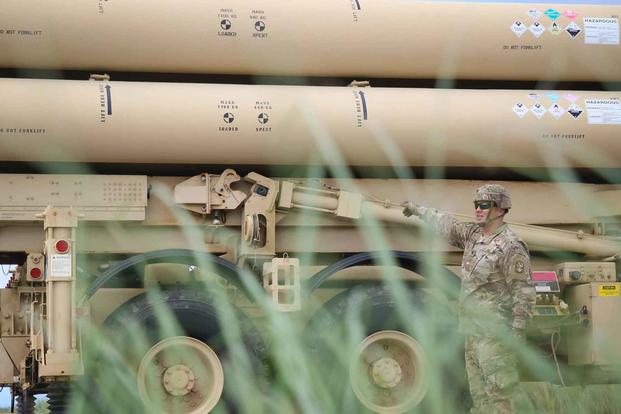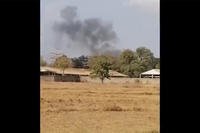Corrosion from seawater. Missiles that lack an updated security system. A confusing reporting and evaluation structure that uses different metrics for assessing unit and equipment readiness.
These are some of the problems the Government Accountability Office found during a recent review of the U.S. missile defense system. Ranging from coast to coast and far abroad, the study painted an alarming picture of America's ability to defend itself from missile attacks and concluded that fixes are needed to address the problems.
After the Cold War ended, missile defense focused mostly on rogue or terrorist missile attacks, as well as capabilities fielded by smaller nations that sometimes work with terrorists. The current system is organized to confront one-off threats of that nature.
Read Next: Lawmakers Advance Bill to Let Disabled Vets Collect Full Benefits, But Hurdles to Passage Remain
Russia's invasion of Ukraine has prominently featured attacks on infrastructure and cities using missiles and drones. Some of these have been thwarted by the delivery of a U.S. Patriot anti-missile system that has drawn rave reviews. The war has once again put missile attacks on America or against troops front of mind for military planners. So, too, the military's overall ability to defend against them.
"These aren't glaring deficiencies; this isn't big red lights flashing on the board. But there are certainly yellow lights," Diana Maurer, the director of defense capabilities and management for the GAO and the study's author, said in an interview with Military.com.
The 10th Missile Defense Battery at the Shariki Communications Site in Japan uses temporary shelters -- tents -- for some of its radar components, and the system itself "faces challenges mitigating corrosion" from seawater, according to the report.
The 100th Missile Defense Brigade and its subordinate 49th Missile Defense Battalion at Fort Greely, Alaska, have had to supplement the security system they use to monitor and guard interceptor fields with foot patrols due to a lack of funding for parts, repairs and upgrades.
The Cobra Dane radar located at Eareckson Air Station in Alaska's Aleutian Islands requires an HVAC system to cool it so it works properly -- but it has not gotten one in part because the Cobra Dane is not always prioritized by base command, per the report.
Meanwhile, the critical report has already produced some results.
Task Force Talon on Guam fields a Terminal High Altitude Area Defense (THAAD) Battery that the GAO report flagged as having "insufficient facilities for maintenance work, spares storage, protection from typhoons, and lavatories with running water." It also struggles with the corrosive effect of seawater.
Indeed, a typhoon did strike Guam just before the report was published. Super Typhoon Mawar, a massive Category 4 storm, made landfall in late May. Guam and the robust military community stationed there are still cleaning up after the disaster. Permanent change of station moves to the island were paused until at least the end of June. Without the necessary structures to protect it, sensitive equipment can easily break or be swept away.
According to Maj. Nicholas Chopp, a spokesperson for the 94th Army Air and Missile Defense Command, "No THAAD equipment was damaged by the typhoon. Some ancillary (support) equipment and facilities were damaged, but none that affect our ability to conduct our mission."
Chopp confirmed by email that base support for the THAAD was, as reported by the GAO, somewhat lackluster, but added that leaders hoped a recent move would resolve those resourcing issues.
"THAAD on Guam was initially emplaced as a temporary deployment, but the facility improvements that should come with the move to permanent stationing have not kept up," Chopp said.
He noted that a recent move to Camp Blaz, run by the Marine Corps, was intended to remedy the shortcomings.
On the sustainment front, the AN/SPY-1 detection system requires a part that a manufacturer stopped producing in 2021. Installed on destroyers, the SPY-1 guides the Navy's AEGIS Combat System. The Navy is upgrading it to the SPY-6 system, but the SPY-1 could be fielded on destroyers through 2060 while upgrades take place.
"Sustainment and all the related issues that go with it -- spare parts, buildings, maintainers, what is the contractor going to do versus what's going to be done organically -- in a lot of cases people don't think about those details, but they're really important," Maurer said.
The GAO identified another, broader problem: Two parallel systems exist for reporting on readiness using different metrics. That could lead to critical systems or units not being mission ready.
The Missile Defense Agency uses the Missile Defense Reporting System, or MDRS, a stand-alone system, while the military services use the Defense Readiness Reporting System-Strategic, or DRRS-S, to track training, maintenance, and availability for use and deployment.
Meanwhile, a relatively new player in missile defense -- the Space Force -- is building its capabilities. One of its new responsibilities is missile detection, but it may not be talking to the other services enough.
Per the GAO report, the Space Force still has a ways to go in cross-service coordination and communication, and "could improve the strategic understanding of missile defense readiness by regularly communicating available readiness data."
So, at what point do enough yellow lights amount to a red light?
Riki Ellison, chairman and founder at Missile Defense Advocacy Alliance, feels that the system itself needs an overhaul.
"We have a problem with roles and responsibilities with integrated missile defense," said Ellison during a phone interview. "It's been OK for checking North Korea and Iran. But when it comes to keeping our soldiers and citizens safe from a near-peer enemy such as China or Russia, our system is inadequate."
Ellison said he is concerned about missile defense capabilities in Poland, Romania and Guam against Russia and China. He also said the systems deployed around Washington, D.C., are not up to the task of protecting against a near-peer enemy.
"The basic fact is that we can't defend our own turf," he said.
Maurer, for her part, feels that, while the report highlighted a number of gaps, they are not beyond fixing.
"The things that we recommended are reasonable. I think they're doable, and I think that they will make the missile defense system that we are continuing to develop and build out for this country even more effective than it is now," Maurer said.
-- Adrian Bonenberger, an Army veteran and graduate of the Columbia University Graduate School of Journalism, reports for Military.com. He can be reached at adrian.bonenberger@monster.com.
Related: Space Force Looking for Surge in Funding for 2023 to Focus on Missile Defense Warning Systems












